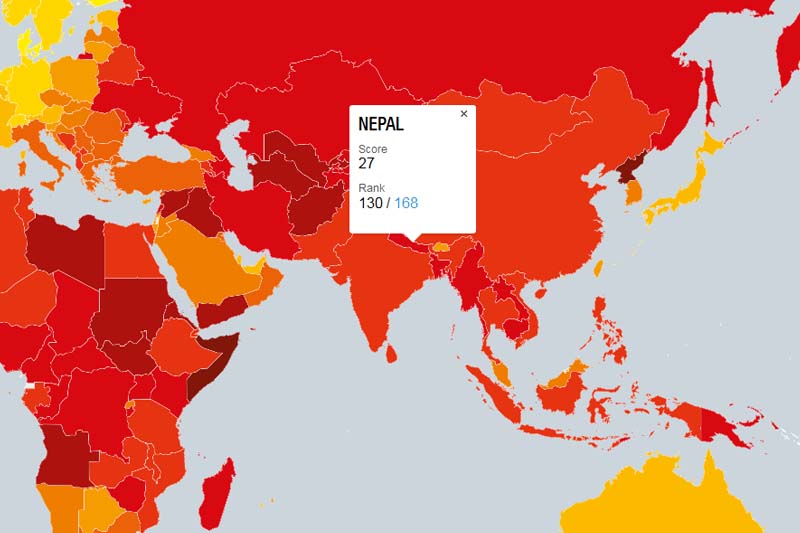Nepal slips four ranks in graft perception index
Kathmandu, January 27
Nepal slipped four positions in the fresh Corruption Perception Index of Transparency International released today.
While Nepal was at the 126th position with a score 29 points in 2014, in 2015 the country was placed at the 130th position with a score of 27 points.
Among the South Asian nations, Nepal is just ahead of Afghanistan (166th position with 11 points) and Bangladesh (139th position with 25 points).
Bhutan is the least corrupt among the South Asian Association for Regional Cooperation members. It is placed at the 27th position with 65 points.
Cameroon, Iran, Nicaragua, Paraguay and Ukraine share Nepal’s position with an equal score.
Following Bhutan are India (76th position with 38 points), Sri Lanka (83rd position with 37 points) and Pakistan (117th position with 30 points). Maldives was not listed in the Index.
A total of 168 nations were included in the study.
Denmark, Finland, Sweden, New Zealand and the Netherlands are the five best performers with 91, 90, 89, 88 and 87 points, respectively.
Likewise, Somalia (placed at 157 position) , North Korea (167) , Afghanistan (166) , Sudan (165) and South Sudan (163) are the worst performers.
Denmark took the top spot for the second year running. The US ranks 16th with a score of 76.
According to TI release, Brazil was the biggest decliner in the index, falling five points and dropping seven positions to 76th. The big decliners in the past four years include Libya, Australia, Brazil, Spain and Turkey.
The big improvers include Greece, Senegal and UK.
In addition to conflict and war, poor governance, weak public institutions like police and the judiciary, and a lack of independence in the media characterise the lowest ranked countries.
A press release issued by Transparency International today said although corruption was still rife globally, more countries improved their scores in the 2015 edition of Transparency International’s corruption perception index than the ones that showed a decline, it added.
Overall, two-thirds of the 168 countries on the 2015 index scored below 50, on a scale from 0 (perceived to be highly corrupt) to 100 (perceived to be very clean).
“Corruption can be beaten if we work together. To stamp out the abuse of power, bribery and shed light on secret deals, citizens must together tell their governments they have had enough,” TI said.
José Ugaz, Chairperson of Transparency International, said 2015 Corruption Perceptions Index clearly showed that corruption remained a blight around the world but it was also a year when people again took to the streets to protest corruption.
“People across the globe sent a strong signal to those in power: it is time to tackle grand corruption,” he added.
Top performers share key characteristics: high levels of press freedom, access to budget information so the public knows where money comes from and how it is spent, high levels of integrity among people in power, and judiciaries that don’t differentiate between rich and poor and are truly independent of other parts of government.
A poor CPI score is a sign of prevalent bribery, lack of punishment for corruption and public institutions that don’t respond to citizens’ needs.






